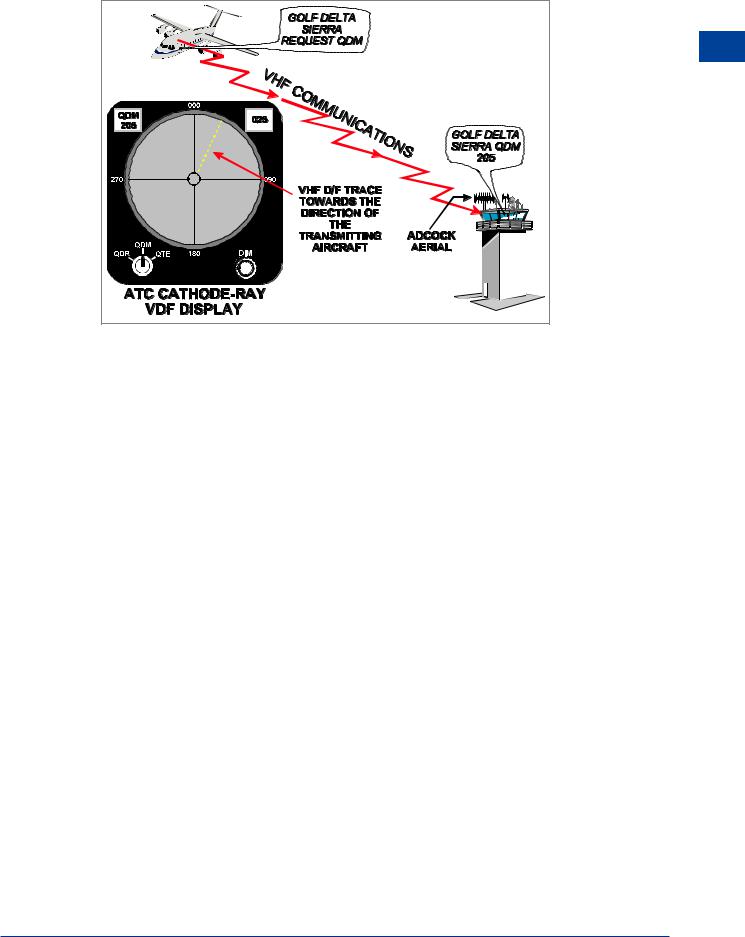
- •Textbook Series
- •Contents
- •ATPL Book 14 Communications
- •1 Definitions
- •Introduction
- •Transmission of Letters and Numbers
- •Definitions
- •Abbreviations
- •Categories of Messages
- •VHF Range
- •2 General Operating Procedures
- •Introduction
- •Technique
- •Transmission of Time
- •Standard Words and Phrases
- •Call Signs
- •Direction Finding (DF)
- •Radio Test Procedures
- •Transfer of Communications
- •Readback
- •Radar Procedures
- •Conditional Clearances
- •3 Phraseology
- •Introduction
- •General Phraseology
- •Area Control Services
- •Approach Control Services
- •Starting Procedures
- •Coordination between ATS Units
- •General Radar Phraseologies
- •Radar in Approach Control Service
- •Surveillance Radar Approach
- •PAR Approach
- •SSR Phraseology
- •8.33 kHz Phraseology
- •Initial Message
- •4 Weather Information
- •Introduction
- •Sources of Weather Information
- •Supplementary Information
- •5 Failures and Emergencies
- •Introduction
- •Communications Failure
- •Emergencies
- •Distress Procedures
- •Urgency Procedures
- •Medical Transports
- •Communications Related to Acts of Unlawful Interference
- •Introduction
- •Call Signs
- •Level Reporting
- •Position Reporting
- •MET Reports
- •Communication Failure under IFR
- •SELCAL
- •NDB Approach Profiles
- •7 VHF Propagation
- •Introduction
- •Radio Frequency Bands
- •VHF Frequency Spread
- •VHF Frequency Separation
- •VHF Propagation Characteristics
- •Factors Affecting VHF Propagation
- •Effective Range of VHF
- •Freak Propagation
- •8 Questions
- •Specimen Questions – IFR
- •9 Index

2 |
|
General Operating Procedures |
|
||
|
|
|
Procedures Operating General 2
Call Signs
Aeronautical Station For aeronautical stations there are of two parts:
•Location name
•Suffix denoting unit or type of service
For example: Brize Radar or Oxford Tower
The suffix indicates the type of unit or service provided, as shown in the list below.
UNIT OR SERVICE |
CALL SIGN SUFFIX |
|
|
|
|
Area control centre |
CONTROL |
|
|
|
|
Radar (in general) |
RADAR |
|
|
|
|
Approach control |
APPROACH |
|
|
|
|
Approach control |
ARRIVAL |
|
radar arrivals |
||
|
||
Approach control |
DEPARTURES |
|
radar departures |
||
|
||
Aerodrome control |
TOWER |
|
|
|
|
Surface movement control |
GROUND |
|
|
|
|
Clearance delivery |
DELIVERY |
|
|
|
|
Precision approach radar |
PRECISION |
|
|
|
|
Direction finding station |
HOMER |
|
|
|
|
Flight information service |
INFORMATION |
|
|
|
|
Apron control/management |
APRON |
|
service |
||
|
||
Company dispatch |
DISPATCH |
|
|
|
|
Aeronautical station |
RADIO |
|
|
|
When satisfactory communication has been established, and provided that it will not be confusing, the name of the location or the call sign suffix may be omitted.
Initial Contact
On initial contact use the full call sign of the station you are speaking to, followed by your full call sign.
60

General Operating Procedures |
|
2 |
|
||
|
|
|
Aircraft Full Call Sign
An aircraft call sign shall be one of the following types:
• Type A aircraft registration marking e.g. G-BTRY ( Note: this may be prefixed by the name of the aircraft manufacturer or aircraft model Piper G-BTRY or Seneca G-BTRY).
• Type B operating agency designator plus last 4 characters of the registration:
SPEEDBIRD ABCD.
• Type C operating agency designator plus flight number
SCANDINAVIAN 937.
General Operating Procedures 2
Aircraft Abbreviated Call Sign
Abbreviated call signs shall be used only after satisfactory communications have been established and provided no confusion is likely to arise.
Only air traffic control may initiate abbreviation of aircraft call signs. Thereafter, the pilots may use abbreviations, but must use full call signs if changing to another station. The call signs would be abbreviated as follows:
• Type A The first character plus at least two last characters:
“G- BTRY” becomes “G-RY” or “G-TRY”.
Note: either the name of the aircraft manufacturer or the aircraft model may be used in place of the first character: “Piper G-BTRY” becomes “Piper RY” or “Piper TRY”.
• Type B The operating agency designator followed by at least two last characters:
”SPEEDBIRD ABCD” becomes “SPEEDBIRD CD” or “SPEEDBIRD BCD”.
• Type C No abbreviation.
Examples of Full and Abbreviated Call Signs
Call Sign |
Type A |
|
Type B |
Type C |
Full |
|
|
|
|
N57826 |
CESSNA |
CITATION |
VARIG |
SCANDINAVIAN |
|
FABCD |
FABCD |
PVMA |
937 |
Abbreviated |
|
|
|
|
N26 |
CESSNA |
CITATION |
VARIG |
(No abbreviated |
|
CD |
CD |
MA |
form) |
|
or |
|
or |
|
N826 |
CESSNA |
CITATION |
VARIG |
|
|
BCD |
BCD |
VMA |
|
61

2 |
|
General Operating Procedures |
|
||
|
|
|
Procedures Operating General 2
Direction Finding (DF)
Q Codes Q codes were used extensively when much of the communication work (especially HF long range) was done in morse code. QNH was quicker to “key in” than A.L.T.I.M.E.T.E.R. S.E.T.T.I.N.G. S.E.A. L.E.V.E.L. P.R.E.S.S.U.R.E.! Today, some Q codes are still widely used because they are useful abbreviations. They are spoken in plain English not phonetically. Commonly used Q codes are listed below.
Q CODE |
MEANING |
QFE |
Atmospheric pressure at aerodrome elevation |
QNH |
Altimeter subscale setting to obtain altitude above mean sea level |
QDM |
Magnetic direction towards a facility |
QDR |
Magnetic bearing (radial) from a facility |
QTE |
True bearing from a facility |
QUJ |
True bearing to a facility |
VHF DF (VDF)
Most air traffic control units (usually on approach frequency) are able to give pilots bearing or direction information based upon the pilot’s transmission. The direction finding equipment can give a “steer”(QDM) towards the aerodrome or the pilot’s true (or magnetic) bearing from the airfield (QTE or QDR).
The pilot in this case could also request a steer e.g.
“QDM QDM QDM Oxford Approach G-BODA request QDM G-BODA”
The transmission ends with the aircraft call sign repeated.
Note: The heading takes no account of wind effects (drift).
62

General Operating Procedures |
|
2 |
|
||
|
|
|
General Operating Procedures 2
Figure 2.1 Ground equipment for VHF direction finding
Class of Bearing
The class of bearing refers to the accuracy of the bearing information as follows:
Class A |
within ± 2° |
Class B |
within ± 5° |
Class C |
within ± 10° |
Class D |
less accurate than Class C |
Radio Test Procedures
Before flight, it is wise to ensure that your radios will transmit and receive properly. In order to do this, a standard procedure is followed for each radio requiring a test. The meaning of this scale is as follows:
Readability Scale |
Meaning |
1 |
Unreadable |
2 |
Readable now and then |
3 |
Readable but with difficulty |
4 |
Readable |
5 |
Perfectly readable |
63
